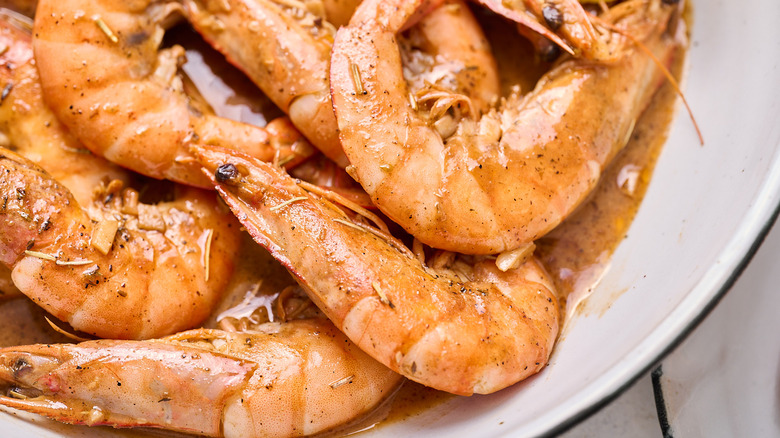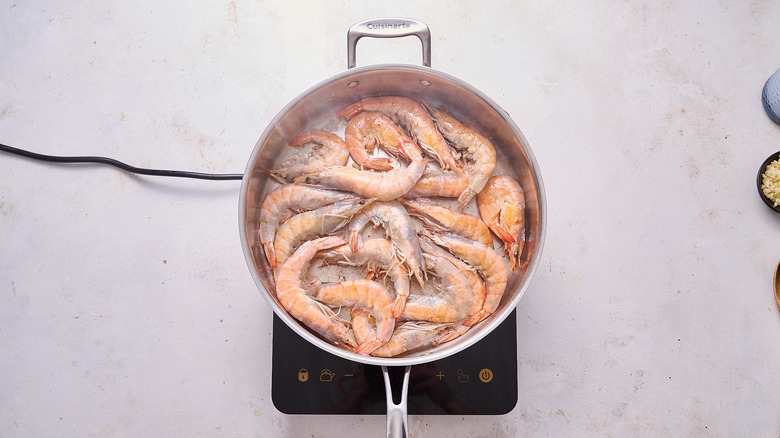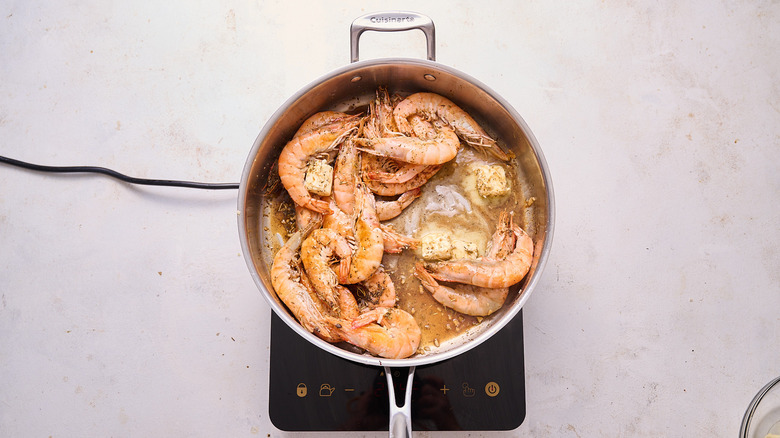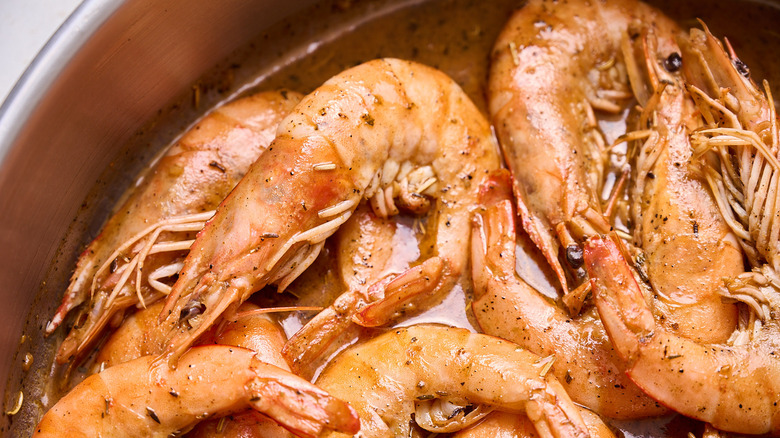New Orleans-Style Barbecue Shrimp Recipe
Perhaps even more so than jazz, Bourbon Street, and Mardi Gras, New Orleans is known for its food. New Orleans' rich history and proximity to shallow bayous has influenced the cuisine we know as Cajun and Creole, which is made up of spicy jambalayas, rich gumbos, creamy étouffée, and plenty of flavorful crawfish. The city and its soulful cuisine has produced some of the world's best chefs, each offering a unique take on classic Cajun and Creole recipes.
One traditional dish that is well known in New Orleans is barbecue shrimp. But, any native Louisianian will tell you that this dish is not meant to be grilled. Instead, it's a simple, saucy dish made with butter, Worcestershire, and lemon that usually only vaguely replicates the taste of a smokey barbecue. What, exactly, this shrimp tastes like is up to the chef preparing it. One of the most famous preparations by Paul Prudhomme only uses a splash of Worcestershire and a half-can of beer, while Pascal's Manale calls for hot sauce and white wine. This version developed with Michelle McGlinn is closer to the famous Mr. B's variation, a creamy, salty, buttery shrimp that is perfect for dipping French bread into. If you like the smoky taste of Worcestershire and the spice of Cajun cuisine, this barbecue shrimp recipe is the perfect way to bring New Orleans home to you.
Gathering the ingredients for New Orleans-style barbecue shrimp
The most important ingredient for barbecue shrimp is head-on, jumbo shrimp. You may need to take a trip to the fishmonger (or Costco) for these, but the head is important for this simple, flavorful sauce. The head of the shrimp is full of fats that melt and emulsify into a creamy, savory sauce. If head-on shrimp freaks you out, you can get away with using jumbo shrimp — just keep the shells on.
From there, the ingredient list is simple: You'll just need butter (a lot of it), garlic, Worcestershire sauce, lemons, and a homemade Creole seasoning made up of cayenne, black pepper, salt, oregano, thyme, and rosemary. You can use premade Creole or Cajun spice mixes, but be sure you aren't using seasoning salt, which will make the sauce too salty.
Step 1: Melt some butter
Melt 2 tablespoons butter in a large skillet over medium heat.
Step 2: Parcook the shrimp
Add the shrimp and cook until slightly pink on either side, about 2–3 minutes. The shrimp will not be cooked all the way through.
Step 3: Cook the garlic
Add the garlic and cook until fragrant, about 1 minute; do not allow the garlic to burn.
Step 4: Deglaze and season
Deglaze the pot with the Worcestershire sauce and lemon juice. Add all of the seasonings and stir to combine.
Step 5: Bring to a simmer and add more butter
Bring the mixture to a low simmer. Add the remaining butter 1 tablespoon at a time, whisking constantly, until all of the butter is incorporated.
Step 6: Serve
Once sauce is thick, creamy, and glossy, remove the pan from the heat and serve.
New Orleans-Style Barbecue Shrimp Recipe
New Orleans-style barbecue shrimp isn't grilled at all. Instead, the shellfish is seared and then coated in a rich, buttery sauce that's full of Cajun spices.

Ingredients
- 1 cup unsalted butter, divided and chilled
- 16 head-on, unpeeled jumbo shrimp
- 4 cloves garlic, minced
- ¼ cup Worcestershire sauce
- 2 lemons, juiced
- 1 teaspoon cayenne pepper
- 1 teaspoon cracked black pepper
- ½ teaspoon salt
- ½ teaspoon oregano
- ½ teaspoon dried thyme
- ½ teaspoon dried rosemary
Directions
- Melt 2 tablespoons butter in a large skillet over medium heat.
- Add the shrimp and cook until slightly pink on either side, about 2–3 minutes. The shrimp will not be cooked all the way through.
- Add the garlic and cook until fragrant, about 1 minute; do not allow the garlic to burn.
- Deglaze the pot with the Worcestershire sauce and lemon juice. Add all of the seasonings and stir to combine.
- Bring the mixture to a low simmer. Add the remaining butter 1 tablespoon at a time, whisking constantly, until all of the butter is incorporated.
- Once sauce is thick, creamy, and glossy, remove the pan from the heat and serve.
Nutrition
| Calories per Serving | 454 |
| Total Fat | 46.5 g |
| Saturated Fat | 28.7 g |
| Trans Fat | 0.0 g |
| Cholesterol | 154.3 mg |
| Total Carbohydrates | 9.2 g |
| Dietary Fiber | 1.7 g |
| Total Sugars | 2.9 g |
| Sodium | 342.8 mg |
| Protein | 3.9 g |
Can I use less butter in this barbecue shrimp recipe?
This barbecue shrimp recipe is closest to the buttery recipe made by Mr. B's restaurant in New Orleans, which boasts rich flavor and a thick sauce. Other versions don't use quite as much butter, though most will use at least one stick. If using two sticks of butter in one dish is not ideal for you, you can make some adjustments for a similar but less buttery shrimp recipe.
Like in Paul Prudhomme's recipe, you could use chicken broth as a base, swirling just 1 stick of butter into the sauce before adding the shrimp. Using chicken broth fills out the sauce without needing the extra stick of butter, and it also makes it much less rich. You can also swap some of the butter for oil or margarine. Lastly, you can test using just a few tablespoons of butter, whisking it into the sauce (we recommend adding chicken broth in this case) until smooth. Note that the less butter you use, the thinner, less rich, and less creamy the sauce will be. This isn't exactly a healthy dish — which is why it's so well-loved!
How should you serve New Orleans barbecue shrimp?
It's hard to read any recipe or speak with any Louisianian about barbecue shrimp without the mention of crusty bread. This simple dish that's made up of just shrimp and sauce. The sauce is delicious, rich, and salty, and it's not to be wasted at the bottom of the bowl. Have plenty of toasted (or grilled) French bread ready to soak up the sauce, which only gets better with the addition of crusty carbs. This is especially true if you're finding the sauce too salty, as the bread cuts some of the salt.
The other unspoken rule with barbecue shrimp is to eat it with your hands — as in, don't be afraid to get a little messy. Grab the saucy shrimp by the head, twist it off, and slide the remaining shell away. Quickly devein the shrimp if that's not already done, then eat the plump meat, dipping it into the sauce for another coating. Lastly, eat it fresh, as soon as possible after you cook it, because the sauce does not make for good leftovers. The butter solidifies in the fridge, and while it can be reheated back to a smooth texture, it is best freshly emulsified in the skillet.










